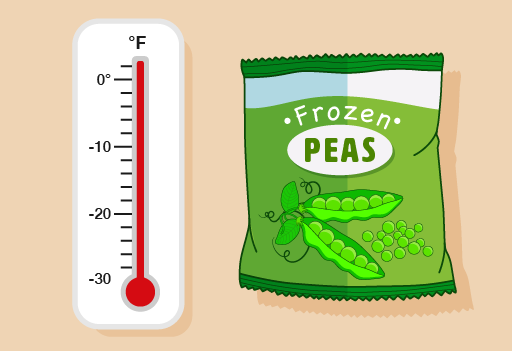5.2 Understanding temperature
Using the right temperature is often a matter of safety. For example, a piece of machinery may not be able to operate properly below a minimum temperature or above a maximum temperature, or a jar of tablets may include advice on its label about what temperature it should be stored at.
Temperatures used to be shown in degrees Fahrenheit. You will still see these measures sometimes. For example:
Note: Fahrenheit is still used in the USA.
Here are some temperatures in Celsius and Fahrenheit:
| Celsius | Fahrenheit |
|---|---|
| –18 | 0 |
| 0 | 32 |
| 10 | 50 |
| 20 | 68 |
| 30 | 86 |
| 40 | 104 |
| 50 | 122 |
Take a look at the example below for comparing temperatures.
Example: Safe storage
You have instructions with chemicals sent from the USA that they must be stored at between 50 and 70°F. The thermometer on the storage tank shows the temperature in degrees Celsius.
Are the chemicals stored safely?
Method
Looking at the temperature comparison chart, 13°C falls in the following range:
- 10°C = 50°F
- 20°C = 68°F
13°C falls between 10°C and 20°C, meaning that it is also in the range between 50°F and 68°F. The chemicals are stored safely.
Now try the following activity. Remember to check your answers once you have completed the questions.
Activity 13: Celsius and Fahrenheit
- A recipe for meringue says you must cook it at 150°C. Your cooker shows temperatures in Fahrenheit. What should you set it to? (Use the conversion chart below to help you.)
| Celsius | Fahrenheit |
|---|---|
| 100 | 212 |
| 150 | 302 |
| 200 | 392 |
| 250 | 482 |
| 300 | 572 |
| 350 | 662 |
- The thermometer on an old freezer shows the temperature in degrees Fahrenheit.
A pack of food has a warning that it must be stored between –12°C and –25°C. Is the food stored safely? (Use the conversion chart below to help you.)
| Celsius | Fahrenheit |
|---|---|
| –30 | –22 |
| –20 | –4 |
| –15 | 5 |
| –10 | 14 |
| –5 | 23 |
| 0 | 32 |
| 10 | 50 |
- A machine must be turned off if the temperature rises above 600°F. Using a Celsius thermometer, you find out that the temperature of the machine is:
Is it safe to leave it turned on? (Use the conversion chart below to help you.)
| Celsius | Fahrenheit |
|---|---|
| 0 | 32 |
| 50 | 122 |
| 100 | 212 |
| 150 | 302 |
| 200 | 392 |
| 250 | 482 |
| 300 | 572 |
| 350 | 662 |
| 400 | 752 |
Answer
- You will see on the conversion chart that 150°C is equivalent to 302°F. The oven would not be marked this accurately, so you should set it to 300°F.
- The thermometer shows 2°F, which you need to fine the Celsius equivalent of. Five degrees Fahrenheit is –15°C; –4°F is –20°C. The temperature is between –15°C and –20°C, so the food is stored safely.
- You need to find 600°F on the chart. You will see that 300°C is 572°F, and that 350°C is more than 600°F. The temperature on the dial is even higher than this, at 370°C. The machine is therefore not safe and must be switched off.
Summary
In this section you have identified and practised:
- how to solve problems requiring calculation incorporating temperature
- the correct way to read temperature and the difference between the units used.





